Related Research Articles

Ambrosius Bosschaert the Elder was a Flemish-born Dutch still life painter and art dealer. He is recognised as one of the earliest painters who created floral still lifes as an independent genre. He founded a dynasty of painters who continued his style of floral and fruit painting and turned Middelburg into the leading centre for flower painting in the Dutch Republic.
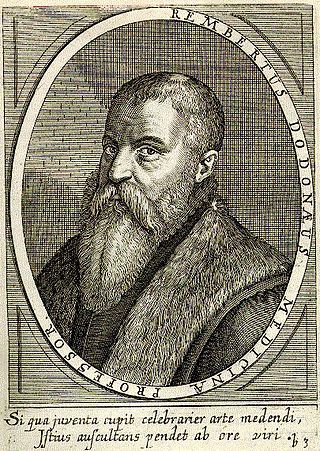
Rembert Dodoens was a Flemish physician and botanist, also known under his Latinized name Rembertus Dodonaeus. He has been called the father of botany. The standard author abbreviation Dodoens is used to indicate this person as the author when citing a botanical name.
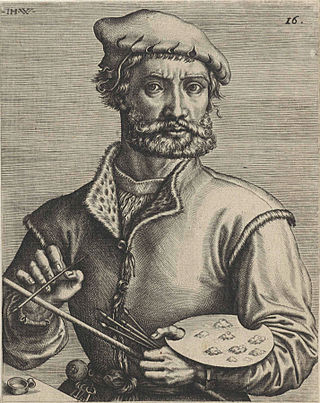
Pieter Coecke van Aelst or Pieter Coecke van Aelst the Elder was a Flemish painter, sculptor, architect, author and designer of woodcuts, goldsmith's work, stained glass and tapestries. His principal subjects were Christian religious themes. He worked in Antwerp and Brussels and was appointed court painter to Charles V, Holy Roman Emperor.

Itinerarium Burdigalense, also known as Itinerarium Hierosolymitanum, is the oldest known Christian itinerarium. It was written by the "Pilgrim of Bordeaux", an anonymous pilgrim from the city of Burdigala in the Roman province of Gallia Aquitania.

Jan Snellinck or Jan Snellinck (I) (c. 1548 – 1 October 1638) was a Flemish painter, draughtsman and designer of tapestries, prints and frescoes. He is known for his large altarpieces and was also recognized as a leading battle painter in his time. Snellinck was active as an art dealer and art collector.

The Guild of Romanists or Confrérie van romanisten was a society which was active in Antwerp from the late 16th to the late 18th century. Its membership was made up of notables and artists from Antwerp who had visited Rome. It offered artists access to the networks of Antwerp's urban elites.

Frans Francken I or Frans Francken the Elder was a Flemish painter who was one of the principal painters in Antwerp during the Counter-Reformation. He is mainly known for his large altarpieces and allegorical paintings. He was a member of the Francken dynasty of painters that played an important role in the Antwerp art scene in the 17th century.
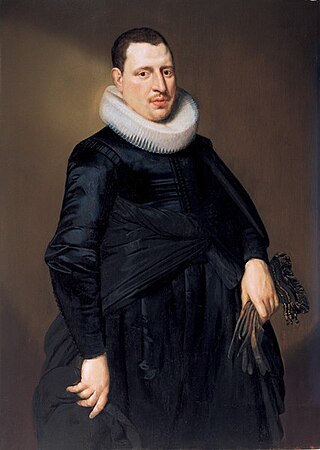
Cornelis van der Voort or van der Voorde was a Dutch Golden Age portrait painter from the early 17th century.
Boetius à Bolswert was a Flemish engraver of Friesland origin. In his time the paintings of Peter Paul Rubens called forth new endeavours by engravers to imitate or reproduce the breadth, density of mass and dynamic illumination of those works. Boetius Bolswert was an important figure in this movement, not least because he was the elder brother and instructor of the engraver Schelte à Bolswert, whose reproductions of Rubens's landscapes were most highly esteemed in their own right.

Jan Peeters the Elder or Johannes Peeters was a Flemish Baroque painter and draughtsman. He is known for his seascapes often depicting stormy seas and shipwrecks as well as for his topographical drawings, many of which were engraved by contemporary printmakers and published by the Antwerp printers.

Marten Pepijn was a Flemish painter who was mainly known for his large-scale history paintings and to a lesser extent for his smaller genre scenes.
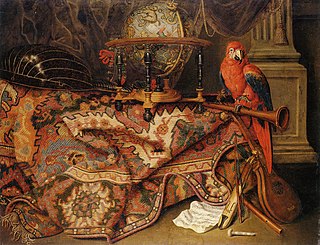
Willem Gabron or Guiliam Gabron, was a Flemish Baroque still life painter, who worked in a wide range of genres including fruit pieces, vanitas still lifes, flower still lifes, game pieces and breakfast pieces. Gabron was also a gifted animalier and often included living animals in his still life scenes. He initially worked in a monochrome style but developed a more colourful palette after a long stay in Italy.

Abraham Matthijs or Abraham Matthys was a Flemish painter and art collector who was active in Antwerp and Italy. He is known for his religious compositions, marine scenes and portraits.
Verdussen was a dynasty of printers in Antwerp, starting with Hieronymus Verdussen I in the late sixteenth century, and ending around 1800. Many other printers in Antwerp were also related to the Verdussens through marriage. They specialized in religious works and works in Spanish, but also published newspapers, almanachs, poetry, scientific works, .... By the end of the 17th century, they produced about 21% of the Spanish books printed in the Netherlands, and with 5 presses was second only to Moretus in Antwerp. In 1876, the Verdussenstraat was named after the family in Antwerp.

Abraham Teniers was a Flemish painter and engraver who specialized in genre paintings of villages, inns and monkey scenes. He was a member of artist family Teniers which came to prominence in the 17th century. He was also active as a publisher.
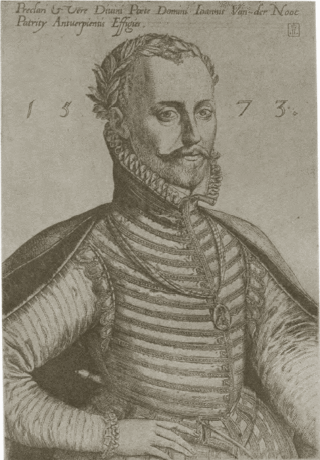
Jonker Jan van der Noot (1539–1595) was a Netherlandish writer who is regarded as the first Renaissance poet in Dutch.
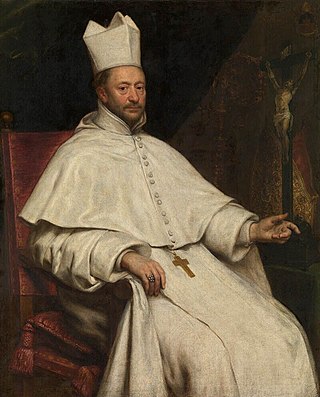
Katharina Pepijn or Catharina Pepijn was a Flemish painter who was known for her history paintings and portraits.

Adrianus or Adriaan van Meerbeeck (1563–1627) was a writer and translator from Antwerp.
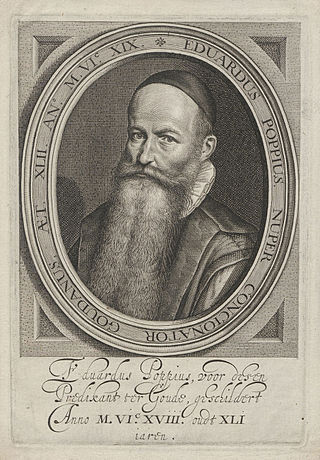
Eduard Poppius was a Dutch pastor and theologian. He was one of the founders of the Remonstrant Brotherhood and a participant to the Synod of Dordrecht.
Nicolaas van Buren (1578–1619), Latinized Nicolaus Burenus, was a Dutch Jesuit and a translator of controversial and devotional writings. Born in Arnhem, he became a Jesuit in 1596, and died in the Spanish Netherlands on 18 October 1619.
References
- ↑ A. J. van der Aa, Biographisch woordenboek der Nederlanden, vol. 3 (Haarlem, 1858), 704-705. Available on Digital Library for Dutch Literature. Accessed 16 November 2015.